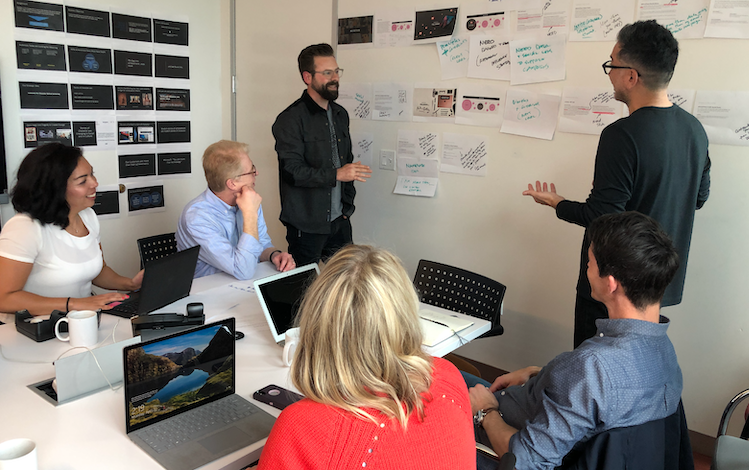

5 Ways to Drive Collaborative Change from the Top
When we think of driving collaboration, we often imagine a group of C-suite leaders engrossed in back-and-forth conversations about how to take far-reaching communication strategies to the next level. While this type of collaboration can be effective, it diminishes what can be an even greater opportunity: leaders engaging their broader employee base for insights into new ways to innovate and evolve their strategies.
If the best results only happen when everyone in your organization is invested in creating positive change, how is your organization empowering your employees? Drawing on new Brands in Motion research from WE, Rethinking the Purpose and Meaning of Leadership, I’ve identified five steps to help leaders listen to, involve and engage their employees to improve their culture and their bottom line.
- Take an inventory of your values
WE’s research, conducted in partnership with YouGov, revealed that 71% of leaders believe articulating core values is more important than it was a year ago.
Especially in light of the events of the past year, employees want transparency and authenticity from their leaders. Luckily, we’re seeing that leaders are taking the time to ask “what do I believe in?” as 86% revealed they’ve become more introspective. This introspection is critical for progress, and once they identify those key values, they must learn to express them and stand behind them.
- Admit what you don’t know – embrace vulnerability
Prior to the pandemic, many of us were accustomed to putting on a brave face at work and leaving our problems at home. But as the impact of COVID-19 wore on it became harder to say, “I’m okay.” In WE’s research 78% of leaders believe they must lead with greater empathy, and one of the best ways they can do this is being willing to expose their own vulnerabilities.
I’ve seen this firsthand with our clients at WE. One recently expressed how they didn’t want to pretend like everything was okay when interacting with their employees – they wanted to share the reality of their struggles working from home. Gone is the mandate that leaders must be strong, bold and unrelenting at any and all costs. This new era requires them to be, first and foremost, human – even if that means admitting to not knowing everything yet – and lead with empathy and compassion.
- Find out what matters
WE’s research revealed that 69% of leaders say stakeholder engagement is one of the most important leadership behaviors in 2021 – but that has to include employees as much as it does external audiences. And it has to become a more regular occurrence. Survey tools and discussion forums are critical assets for listening and talking to your key audiences. However, in an email- and Zoom-fatigued world, these tools need to be used thoughtfully.
In a survey conducted by Wakefield Research, 89% of workers said daily tasks such as sorting through an inbox of unopened emails or navigating incoming instant messages are some of the most unpleasant parts of working remotely. Get to know the rhythm of your company so you can communicate smarter. Facilitate communication and collaboration across business groups vs. inundating your people with too many communications when they are already feeling overwhelmed.
- Create action – walk the walk
This all said, employees don’t want lip service. They want to know that leaders are following up on their promises and enacting change. Once you’ve established how to engage with your employees, sharing how you’re walking the walk will be critical for driving successful collaboration. And again, that doesn’t mean an annual update. WE’s research found 56% of leaders are working to develop a deeper understanding of how their actions affect others in “real time,” not just retrospectively.
For those unsure of where to start, think about how you can encourage two-way dialogue. Focus groups, for example, are a great opportunity to understand important topics that require deeper attention, especially when being accountable with your own progress. This is only the beginning. Whatever you choose, find your benchmark, and define a small handful of measures you can start with.
- Keep the momentum
When looking to drive collaboration with employees, it’s important to understand it’s never a one-and-done situation. These five steps should be used in cycles, as you’ll likely find yourself needing to come back, reevaluate and readjust time and again.
If there is one thing the past year has taught us, it is that anything you implement may not be relevant six months or a year from now. Continue to listen to, learn from, and engage with your employees. This isn’t about knowing all the answers – it’s about taking steps to drive meaningful collaboration with your internal stakeholders. It’s a journey, not a destination. No-one’s looking for perfection, but being more human, that’s something we all need more of.
WE’s Rethinking the Purpose and Meaning of Leadership research in partnership with YouGov uncovers trends and insights from more than 300 global business leaders about how the events of the last year reshaped leadership expectations, unlocking new ways to lead through introspection and determination.
The latest blogs from WE
Decoding Gen Alpha: A Primer on the Next Gen of Consumers
Why Gen Alpha Will Fuel Spending This Season
Why Reputation Is a Business Driver in Healthcare


